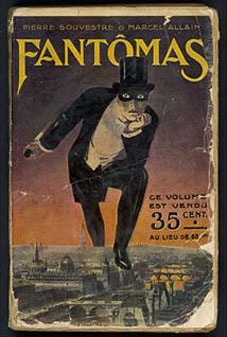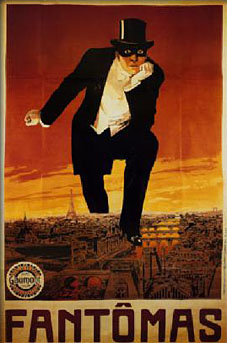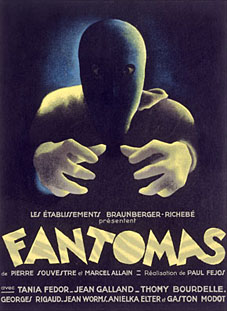…Fantômas was championed by the Parisian avant-garde, first by the young poets gathered around Guillaume Apollinaire, who, together with Max Jacob, founded a Société des Amis de Fantômas in 1913, and later by the surrealists. In July 1914, in the literary review Mercure de France, Apollinaire declared the imaginary richness of Fantômas unparalleled. The same month, in Apollinaire’s own review, Les Soirées de Paris, Maurice Raynal proclaimed Feuillade’s Fantômas saturated with genius. Over the next two decades, poets such as Blaise Cendrars (who called the series “The Aeneid of Modern Times”), Max Jacob, Jean Cocteau, and Robert Desnos, and painters such as Juan Gris, Yves Tanguy, and René Magritte, incorporated Fantômas motifs into their works. Pierre Prévert’s 1928 film, Paris la Belle, featured a Fantômas book cover in the closing sequence, and the Lord of Terror was adapted to the surrealist screen in Ernest Moerman’s 1936 film short, Mr. Fantômas, Chapitre 280,000. As the century progresses, Fantômas remained a minor source of artistic inspiration as the subject of cultural nostalgia.
Continued here.




“enfantomastic” – James Joyce
Ah, yes. For some reason I always forget Joyce was a fan. He liked Krazy Kat as well, which is understandable given Herriman’s word-play.
I just bought this book! The Penguin Classics edition’s cover is similar to the second image here, but cropped down to just above Fantômas’s eyes and with a sketch of the Eiffel Tower added just behind him.
(I found out about Fantômas after looking into Dr. Mabuse, a similar evil criminal mastermind, whose name was used as the name of a ship in Charlie Stross’s The Jennifer Morgue. You’ve got to love Wikipedia.)
(I also just got the most recent Krazy Kat reprint volume… should I be nervous?)
Oh, is it still in print? I remember the Penguin edition, ought to see if I can find a copy.
Fantômas is one of those Ur-characters that seems to inspire a mass of similar types. So, yes, Mabuse is one. The Mabuse films made by Fritz Lang are probably inspired by the Feuillade Fantômas serials since Lang expert Lotte Eisner notes borrowings from Feuillade in one of his early films. And in Britain we had Monsieur Zenith the Albino in the Sexton Blake stories.
Krazy Kat rules! I’d be overjoyed if I were you.
“For some reason I always forget Joyce was a fan”
I think they used “enfantomastic” – James Joyce as a front or back cover quote on the penguin edition. Unfortunately I’ve lost my copy.
Was trying to search the text of Finnegans Wake online to find the actual source but none of the online search engines seem to work
:-(
It’s not in the Finnegans Wake Concordance so may be something he said elsewhere.
http://www.kirbymountain.com/FWconcordance/
wow what a great concordance.
Google search came up with
http://www.premiumwanadoo.com/fantomasfr/Fant468.htm
Quotes from Apollinaire, Cocteau, Louis Malle but no sources cited.
Will have to see if it’s mentioned in the Richard Ellman Joyce biography somewhere.
Well it wasn’t in the Richard Ellman index so maybe it was just in a letter he wrote. Wonder where it does come from originally.
It was actually the Picador edition. First British publication 1987. Introduction by John Ashbery.
Can’t find an image online but FANTOMAS is written across the top of his body with the O and M covering his eyes.
Also similar to the second image but the sky is blue not red. Also very sharp knife visible in his right hand.The Joyce quote is to the right of his leg.
From the introduction
Stretching his immense shadow
Across the world and across Paris
What is this gray-eyed specter
Rising out of the silence?
Fantomas might it be you
Lurking on the rooftops
– Robert Desnos, “Complaint of Fantomas”
according to the introduction this was
“set to music by Kurt Weil (What, one wonders, has happened to the score?)
There’s a few Joyce morsels like that. He wrote a great promotional poem for Finnegan–Humpty Dump Dublin–that was never used but which Anthony Burgess runs in his introduction to the book.
First I’ve heard of a Kurt Weill connection!
Some book on murder movies by CreationBooks had a special chapter on seemingly unstoppable, invisible rogue masterminds whose intelligence confounds those pursuing just as much as their blood lust appalls. The author refered to them as ‘Sadean villains’ . While I’ve nothing against de Sade, I’d say Fantomas is a more accurate would-be archetype for characters like those.